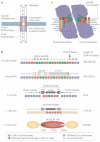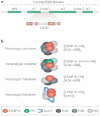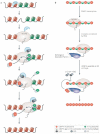Epigenetic regulation of centromeric chromatin: old dogs, new tricks?
- PMID: 19002142
- PMCID: PMC2586333
- DOI: 10.1038/nrg2466
Epigenetic regulation of centromeric chromatin: old dogs, new tricks?
Abstract
The assembly of just a single kinetochore at the centromere of each sister chromatid is essential for accurate chromosome segregation during cell division. Surprisingly, despite their vital function, centromeres show considerable plasticity with respect to their chromosomal locations and activity. The establishment and maintenance of centromeric chromatin, and therefore the location of kinetochores, is epigenetically regulated. The histone H3 variant CENP-A is the key determinant of centromere identity and kinetochore assembly. Recent studies have identified many factors that affect CENP-A localization, but their precise roles in this process are unknown. We build on these advances and on new information about the timing of CENP-A assembly during the cell cycle to propose new models for how centromeric chromatin is established and propagated.
Figures






References
-
- Hassold T, Hunt P. To err (meiotically) is human: the genesis of human aneuploidy. Nature Rev. Genet. 2001;2:280–291. - PubMed
-
- Monaco ZL, Moralli D. Progress in artificial chromosome technology. Biochem. Soc. Trans. 2006;34:324–327. - PubMed
-
- Westermann S, Drubin DG, Barnes G. Structures and functions of yeast kinetochore complexes. Annu. Rev. Biochem. 2007;76:563–591. - PubMed
Publication types
MeSH terms
Substances
Grants and funding
LinkOut - more resources
Full Text Sources

